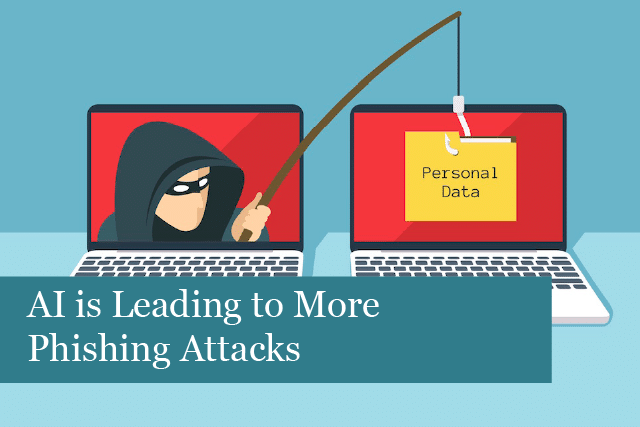
The wonderful world of AI has made many aspects of our lives easier. We can easily access assistants such as Siri or Alexa to help automate certain tasks, freeing us up for more important work. This is all great!
However, AI also has a downside; these days, it’s increasingly used by hackers in cyberattacks. These are a fresh twist on the old phishing game.
How is AI Used in Cyber Attacks?
Cyberattacks are on the increase; in fact, a study by Juniper Research estimates that attacks will cost $2 trillion for companies around the world. What’s driving this increase? It’s due to cyber criminals making use of social engineering factors, combined with AI. That’s a dangerous combination on the web.
What is social engineering? It’s the process of using deception to make people hand over personal details or confidential information. The combination of AI and social engineering has made criminals even more successful in their attacks. AI makes it easy to impersonate a company or individual along with call monitoring in phishing attacks, especially over the phone.
For example, it’s possible for a hacker to download any video online. It may perhaps be of an important person giving a talk, such as well-known CEO or even a famous sportsperson. Today’s technology makes it easy to grab the video from social media feeds, and take a voice snippet to create a voice key, which can then be used on voice-activated devices and platforms.
The scary part is that criminals don’t even need to download a video. They can use other types of technology to obtain the snippet of a person’s voice, then use it to place a call. Hackers know that it doesn’t take a large piece of voice data to cause a major problem.
New AI Threats
These days it’s not even necessary to use an email to phish for data. Instead, AI chatbots can do the work and do it quite easily. AI chatbots can trick a person to click on a bad link, for instance. It can also be used to monitor a person’s behavior, which can then be used for automated phishing attacks that are quite effective.
Understand, AI being used in cyber attacks is no trivial matter. Attacks can cause disruptions in delivery of utilities (such as gas, water, and electricity). It can also be used to cause issues when communicating with first responders and even completely cause a website to go down. Attackers are becoming more creative when it comes to adapting technology innovations to wreak havoc.
IoT & Cyber Attacks Using AI
The Internet of Things is another area where criminals are increasingly using AI to remotely attack networks. Many of our every day devices including laptops, smartphones, tablets, etc. connect to the Internet. Not only that, but even devices and appliances in our homes, such as refrigerators, smart TVs, and more, access the Internet. All of these connected devices can now be accessed by cyber criminals using AI.
With AI and IoT, hackers can change the temperature on your smart thermostat. They can also intrude into your home through any connected cameras in your home or business. The types of devices criminals are able to access through AI software is increasing every day.
It’s Not All Bad News
While cyber criminals can cause serious problems by using AI, it’s not all bad news. AI can also be used to combat hackers and their tactics. Developers are already creating cybersecurity defense mechanisms that utilize AI, with the goal of stopping hackers in their tracks.
We’re already familiar with SSL and TLS certificates on website, which give you some relief knowing the site is protecting you and your data. Additional layers of encryption can further strengthen the security of websites, protecting them and the user from malicious attacks. This can be accomplished by using AI.
AI software is increasingly being used against the bad guys when it comes to cyber security. Right now, the emphasis is being placed on conducting predictive analysis, on a scale that’s impossible for humans. AI can swiftly sift through data, looking for any irregularities, alerting technicians and others to intrusions and taking action before the attack even begins.
Another new use of AI is increasing the security of passwords and authentication measures. Cyber crooks have always targeted passwords. Why? Because this is an easy of social engineering. They understand human nature—we take the easy way whenever possible. When it comes to passwords, many people have tendency to use the same password across numerous sites. If a criminal finds the password, all they have do to is plug it in across several popular sites and access the person’s data.
Deployment of AI in Cyber Security
To combat this tendency, AI is being used to make authentication measures harder to break. Here, think of Apple’s Face ID. The AI in this software processes the user’s face in order to unlock the phone. The software identifies correlations and patterns to open your iPhone.
The software can even be deployed to monitor and determine a user’s level of access on a company network. It works with employees, partners, suppliers, and customers—making sure everyone can access what they need, but only that and nothing more.
AI software is fast becoming a tool to strengthen our current security measures, and in some cases even replace them altogether. It’s increasingly aiding the fight against hackers to stop their attacks, before they come catastrophic.
AI Cyber Security is the New Tactic to Protect Your Business
Businesses of all types and sizes face the increased threat of being attacked by hackers. It only takes one attack to bring a business down, possibly closing it forever. With the use of AI, a company’s security will be able to count on an additional layer of protection against such attacks.
Consider this the AI arms race—it’s time to add AI security methods to your business. Hackers and cyber criminals are more determined now than ever; using AI to improve the quality and strength of your cyber security is necessary—it’s not an option.
Recommended Posts

IT Simplified: What Is A Firewall?
21st March 2025

10 cyber security tips
14th March 2025

